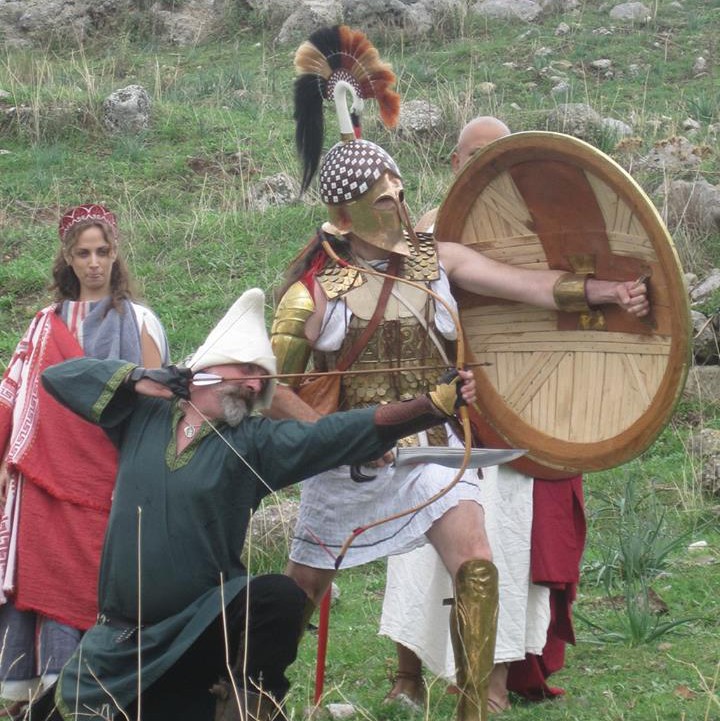via The Traitor Son Cycle is the Perfect Hair of the Dog for your Game of Thrones Hangover
A Newcomers Road to Plataea
StandardBy Aristotle Koskinas
(NB Aristotle is a scholar, archaeologist, and professional guide in Greece. He joined us to provide language support at Marathon 2015. He has led us on a battlefield walk at Plataea (about 15 of us) and he’s otherwise brand new to reenacting. I thought, based on some feedback I’ve received, that some of you who are ‘on the fence’ about making kit, spending money, and attending this event might like to hear from a fellow newcomer to the world of ‘dress up with weapons.’ Oh, also: Aristotle is too modest. He is, in fact, the driving force in Greece towards getting us a site and the cooperation of the locality and the Greek government. Enjoy! CGC)

In two years’ time, the reenactment of the battle of Platea will take place at the very plain where it was fought. My aim is to be part of this fascinating event, after a journey that began for me in Marathon (as was the case for many of those who fought in Plataea, 2,500 years ago).
I am the kind of archaeologist who is less interested in art and more drawn to military history and technology. I had always wanted to go beyond theoretical knowledge to another level, that of experimental archaeology and historical reenactment, which would bring me in a more direct contact with the things that I had studied so avidly.
Few groups of historical reenactment exist in Greece, but most are devoted to classical antiquity. Yet I hesitated joining them, either because the quality of their reproductions left a lot to be desired (even without an archaeologist’s eye for detail) or because I couldn’t agree with their ideology.
It was a surprise for me to learn that in November 2015 there would be an event at the site of the battle of Marathon, held by an international federation of reenactors. A group of guides, including myself, were asked to volunteer as interpreters between the reenactors and the public.

This was serendipity at its best, a dream come true. I was lucky to be assigned to a team of excellent reenactors, such as Christian Cameron, Yannis Kadoglou and Paul Bardunias, among others. Together we showed to several school groups the gear ancient hoplites brought to battle and we talked about how they fought and how their daily life was while on campaign.
This was my first step on the road to Plataea. The next one was at Plataea itself, a few days later, when I escorted a small group of the reenactors to its battlefield.

I didn’t need much more in the way of encouragement to join the reenactors’ ranks. I soon began a process of communication and exchange of knowledge in order to get the gear I needed for the full kit of a Greek hoplite of the early classical period.
I first invested in a shield and a Corinthian type helmet. After many queries and a long online search, I found a used set from Radostin Kolchev, a reenactor and craftsperson in Bulgaria.
But helmet and shield do not a hoplite make. The next year I went forward with the soft kit, namely a chiton and a chlamys. Unfortunately, I am not the kind of person who can weave or cut and stitch leather. I can’t even hold a needle, much less use one. Nevertheless, I wanted my gear to be as authentic as possible, and not use modern textiles. Ι was brought into contact with Aurora Simmons, reenactor and craftsperson, who makes jewelry and historic outfits in Canada. After a long correspondence with her (and with the help and advice of more experienced reenactors) I chose textiles and colors that would be as close as possible to the ones ancient Greeks probably used. The textiles were traditionally woven in the Himalayas with wool from Australia; they then traveled to Canada to be put together according to the designs of a Greek reenactor, based on images found in ancient art and circulated around the world via the World Wide Web.

This odd version of globalization was long, complicated and expensive, but was chosen as an experiment, to see how close one could get to reproducing clothing of the classical period. It is not necessary for a novice reenactor to go to such lengths in search of authenticity – there are textiles that come close to the original and are much more easily and cheaply available. I need to stress here that none of what I did would have been possible without the assistance and valuable advice of more experienced reenactors.
The next step was a pair of sandals and a leather purse, both made by the excellent craftsperson and passionate reenactor Yannis Kadoglou of Alexandroupolis, Greece. The sandals’ design was copied from ancient artwork; as for the purse, I use it to store my small collection of reproductions of ancient coins).
While these last two steps were in process, I informally joined two reenactment groups, the Rheseidai and The Plataeans. Soon they were both abuzz with a discussion about a reenactment of the battle of Plataia; it was decided to hold it in 2021, to celebrate 2,500 years since this pivotal historic event.
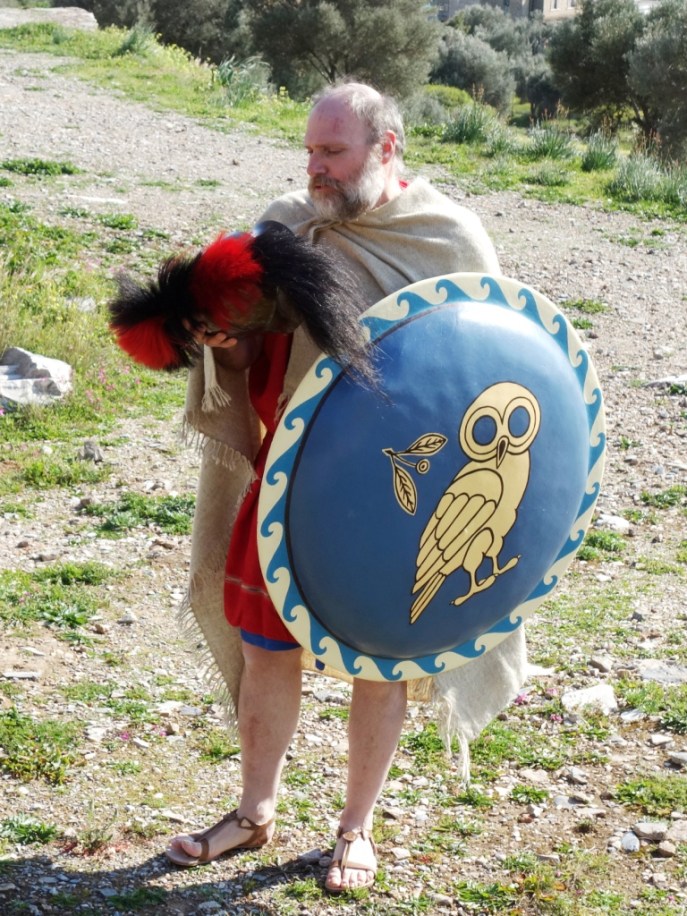
This means that I only have two years to complete my kit so that I can stand in the battlefield of Plataea in full battle gear. I need a thorax, a sword and a spear, as well as a multitude of other things, such as a hat, a cup, and a sack to put it all in. For authenticity’s sake, I’d also need a boy to carry it all, I say looking hopefully at my rapidly growing eldest son, who likes the idea of taking part in the reenactment but is much less enthusiastic about the carrying part.
In the mean time, my gear is not gathering dust: although still incomplete, it has proved itself useful in presentations about the Persian wars and ancient Greek hoplites that I’ve made to groups of tourists or schools.

Among hobbies, reenactment is neither the easiest, nor the cheapest. This can be said of many other things, but starting out is always made easier when there is a team to support the novice and help them in their first steps. My experience has shown me that the community of reenactors embraces newcomers and is eager to support them by freely providing advice and assistance.
Besides the immense personal satisfaction that I get from historical reenactment, it has also proved to be one of the most powerful educational experiences I’ve ever had. I considered myself knowledgeable in the practice and technical details of ancient Greek warfare. Yet, through the process of choosing and acquiring my gear, of wearing and explaining it to others, I experienced firsthand things that I only knew theoretically before and learned others that I did not know. I am certain that I am going to learn much more along the way.
Being able to stand on the footsteps of my ancestors and reenact an ancient Greek hoplite on the battlefield of Plataea will be –to me– a priceless experience. In order to make it I will even try to bring this ageing and less-than-athletic archaeologist into shape.
I hope you will join me in sharing this unique experience.
Aristotle Koskinas
(My right hand is healing nicely and I’ll be back to write my own blog next week. This blog will also be migrating to my ChristianCameronAuthor.com site in the next month… please look for it there.And feel free to join up for Marathon. The next blog will be about where to buy kit, especially long lead time items that, quite frankly, you may wish to order now!)
The Road to Plataea 2021 — The Cavalry Commander Speaks
StandardPlataea 2021 isn’t all about me. I’ll be having guest bloggers discuss their preparations over the next year. Also, I hut my hand and can’t really type right now, so over to the Hipparchos, John Conyard. Next edition will be on making your kit. CGC
My name is John Conyard, I live in York in the UK, and like many of Christian’s readers, I am passionate about recreating the past. Most weekends you will find me recreating one period or another, often on horseback.

- Riding as a Greek with a Classic posture, but the helmet is too late for Plataea.
Back in October 2015, after a hard season re-enacting, a couple of us were committed to attend the event at Marathon organised by Christian on the actual site of the battle. But Greece seemed a long way away, ten days out of my calendar seemed a long time, and I had not met the organisers, so it all seemed a bit nebulous. The evening before we set off we did our final supermarket shop and topped up with petrol. We looked at each other, and decided to make the trip a reality. It was a great decision, and one of the best experiences of my life. We drove across France and northern Italy, getting the ferry to Greece, and then enjoyed a few days in Athens before setting up camp on the beach at Marathon. Everything is possible if you set your mind to it, and the journey was in some ways as important as the actual event.

- On the beach at Marathon
To many of you Plataea in July 2021 may seem a long time in the future and the idea of re-enacting in Greece may seem a dream, but hundreds of people across the world are beginning to plan for this anniversary. The event has local support and a great team behind it. Whether you are a hardened re-enactor with over 30 years experience, or somebody who would like to make this their first event, I would strongly suggest you start making your own plans now. You can make this happen with very little effort.
We intend to have a large number of horses at the event and I am putting together a team of riders. The battle saw the largest concentration of Greek cavalry during the wars, all fighting on the Persian side. So many of us are putting together Greek as well as Scythian or Persian equipment. Please take a look at my facebook photo albums or at www.comitatus.net for ideas. At this stage I have no idea what the horses will be like, their size or their experience. So we will plan for everything. Riders will be riding bareback or on a fur, saddle cloths, or Scythian saddle pads. It is generally wise to keep the bit the horse is used to, but period bridles would be great, based on simple Western bridles without buckles. Ideally riders will be able to vault, stationary and at the canter, mount from both sides, be used to horse archery, lances, javelins and hand held weapons. We plan on doing mounted displays and hopefully use the horses in a battle scenario. This may sound difficult to achieve, but if it was easy everybody would be doing it, and this will be special.

- A good symmetrical bow, with some blunt arrows are needed to play a Scyth or Persian. A gorytos is relatively easy to make.
Re-enactment is not just about wearing fancy dress or even historically accurate clothing and equipment. It is about reconstructing accurate clothing and equipment which is fit for purpose, in which you can run, fight, sleep and ride. This means we often have to learn how to make it, how to repair it and how to use it. Re-enactment is a great hobby with many facets, but for me learning the skills necessary to use period equipment is all-important. So as the Ancients tell us, riders should be able to vault, shoot the bow, and use the lance. Riders must be able to get the best out of their mount, please do not expect your horse to show you off to your best advantage. I really do not care if you are the world’s greatest rider or an enthusiastic novice who has worked hard, but I would like everybody to ride within themselves safely, doing a steady professional job.
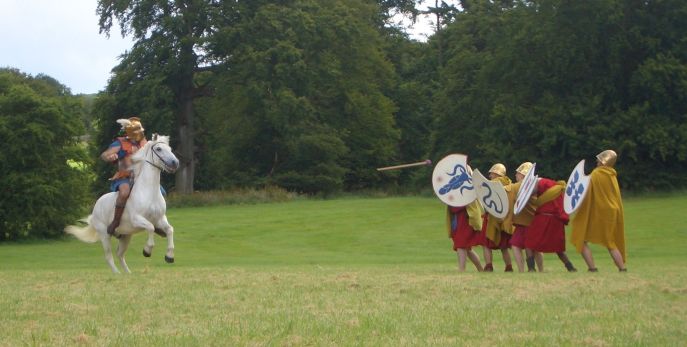
- Weapons displays will involve riding the horse first, then using the weapons. There will be no roped off tracks for the horses to follow.
This is perhaps not the place for detailed kit guides (http://www.comitatus.net/greek.html) but there is a facebook group to which I can add you that will answer many of your questions. The group also includes many of those from the UK who want to attend. Both female and male riders are welcome. Women generally portray Scythians, however they are also often the correct weight and build to portray the Greek riders of the period. Too many male re-enactors, myself included, are too old, too heavy or too tall. But we must insist that you look the part and that you are convincing as a soldier close up. Which means riders must be comfortable carrying and using their equipment, female legs and unauthentic tattoos must be covered, and glasses and modern safety equipment be left behind. Many of us will be riding without helmets and I expect the ground will be rocky and baked hard, so get yourself some insurance.

- Elizabeth Usher portraying a Scythian. Corinthian helmets will be a common sight at Plataea. Leather, felt, wool, linen and silk are all appropriate for a Scyth.
It is generally a pleasure to spend time getting to know and taking care of horses. So ideally we will be camping near them. Indeed if you can, staying in a period encampment is a great way of immersing yourself in the past. At this time armies camped in informal mess groups of friends and relatives around a fire, and if the group got too large it had to split. Cavalry, hoplites and everybody else mixed together. Cooking equipment is simple, I manage with a copper or bronze pot and some iron spits, but you can still turn out interesting meals. People slept on rush mats in their cloaks, simple tents and shelters, with an awning keeping off the sun. The period encampments at the event will be brilliant, a simple functional arrangement where people can cook, eat and drink together enjoying the special atmosphere. And they will act as a base from which we can engage the public in polite conversation, at set times, and from a safe distance.

- Camping on the beach at Marathon, two simple tents and an awning for kit and cooking.
Please find me on facebook or via my website www.historicalinterpretations.org, take a look at www.comitatus.net and the Comitatus facebook page. If you are interested in the cavalry or live in the UK please contact me about joining the facebook group which will keep you up to date and be able to offer advice. This really is something you can be part of, and it just may be the best thing you will ever do vertically.
John Conyard
www.historicalinterpretations.org
Running to Plataea — The Road to Plataea Part 2
Standard
Those aren’t just hoplites in that image; those are runners, taking part in the Ancient Greek sport of running in armour. The last two big reenactments we’ve held in Greece, we’ve actually run the race in armour; sacred games to the memory of the dead of Marathon (and Plataea) were part of the religious practice, and we recreate some of that, too.
But today’s blog is about building kit for Plataea, and the cheapest, best kit you can build, if you want to go reenact in Greece for seven days, or just live a better, longer life, is your body. You see all those pictures where Greeks are naked? In the military classes, having a well-toned body was a visible sign of your fitness to take on the role of a citizen; to fight in the phalanx, to vote, to consider the complex issues of ‘politics.’ There was no higher fashion than fitness. This passion for fitness was not limited to men; women ran races, lifted weights, and shot bows; indeed, an strong argument can be made that the whole institution of Brauron, a temple of Artemis in Attica, was purely for the training of Athenian girls in archery, horseback riding, running, and other sports.

Look, I’m not particularly interested in the world of fitness and routines and all that. I’m mostly interested in two things; people fit enough to reenact for a week in Greece (and ENJOY it) and people with enough stamina to do some training in various Greek martial activities.
So… running. Also walking.
You are welcome to lift weights, join a club, hire fitness coaches; sure. Have washboard abs (I will not). But really, this should be the cheapest part of your kit. I’m not interested in shaming ANYONE and I full realize that some very good reenactors just can’t run or walk distances,; they have injuries, health problems, etc. We do NOT exclude (if we have a motto it would be ‘we don’t exclude.’)
That said, you’ll have a much better time if you are fit. You will also look more like an Ancient Greek. Look at the iconography; look at the representations of men and women on vases and in statues.
Side note: You will not be asked to stand around naked. But people did. Young men apparently went out wearing only a chlamys (a short cloak) to show their fitness (possibly to appeal to the girl or boy across the street, too, but we leave that for another blog). Next week, when we talk about making basic clothes for men and women, you’ll see how very little you are wearing… (which is a benefit in Greece in July, I promise).
Okay. Fitness. How to get there?
Run. Or walk. Maybe both.
If you start slowly and run just 30 minutes a day, three times a week, from now until July 2021, I guarantee that you will have the fitness and stamina to take part in every element of our reenactment. And reenacting is fatiguing, whether you are answering questions from excited school groups or marching for miles across the ancient battlefield, on the look out for the deadly Persian Cavalry (we are doing that, btw). Cooking all day is fatiguing; weaving all day is fatiguing. Its all more fun if you can do it without feeling physically ill. Don’t be ‘tough.’ Be ready.
If (like me) you are reaching an age where running is too hard on the knees, try walking. Last year, some friends of mine and I walked the Camino Primitivo in Spain (in Medieval kit, of course, because…)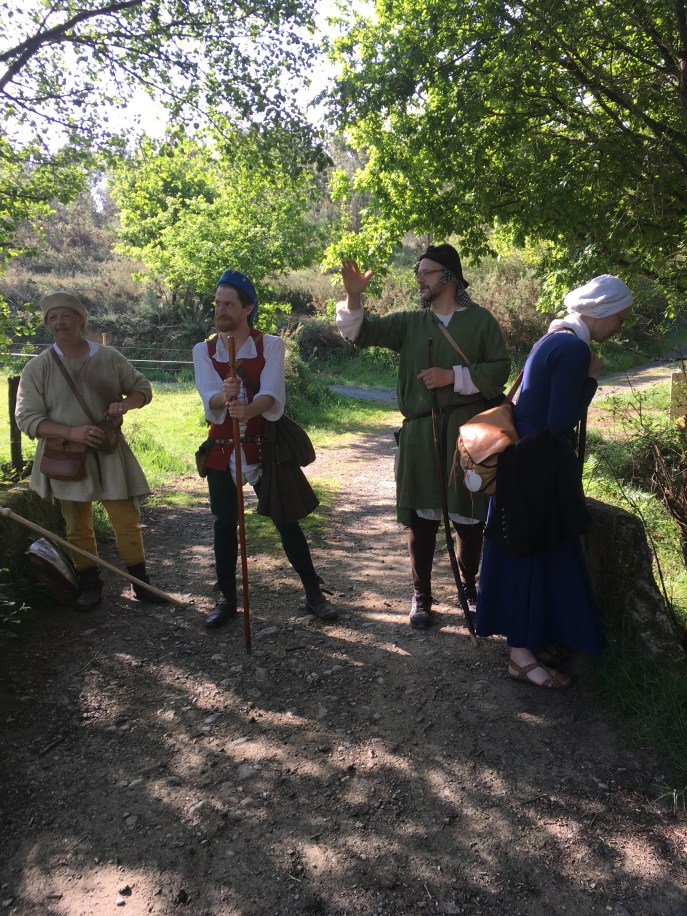
In the preparation, I walked hundreds of kilometers, and then, on Camino, another 400 or so. Walking is fabulous exercise. You just need to do a lot of it. Build up to an hour a day. Or even more.
Side benefit; I got to know my city in ways I’d never seen Toronto before. Walking is remarkable (I know, much smarter people than me have said this) because you have time to look around.
Over the summer, with the help of an intern (long story there) Aurora Simmons and I will put up some videos on the basic exercises of Greek martial arts; basically, single exercises you can do to prepare for handling a shield and spear or sword. But really (really) the martial element of exercise, and even of the reenactment, is not (not) the most important part. A good camp; with cooking, crafts, and celebrations of the life of the Ancient Greeks and Persians, will be the centerpiece. You won’t want to miss any of that…
So be ready.
The Road to Plataea 2021– Part 1
Standard
In July of 2021 at Plataea in Greece, some dedicated reenactors will attempt to portray the cultures of Ancient Greece and Persia, and some aspects of the battle that changed the world.
The photo above was taken at Plataea in 2014; that’s me in hoplite panoply, with Chris Verwijmeren of Holland as an archer, Jevon Garrett (USA) as a Greek gentleman as well as Giannis and Smaro Kadaglou of Alexandroupolis, Greece as a hoplite and Greek woman of 500BCE (both a little hidden by my shield). The photo exemplifies almost everything I believe about reenacting, despite it’s flaws; inclusivity; careful research, location, experiment. Those of you who read this blog (hello! I’m back) know I use another photo shot the same day as my signature…

I have a great deal to say about reenacting the Battle of Plataea and the cultures of the people who were there, and blogs are short. I’ll do my best to encapsulate what I have to say.
- Why reenact Plataea? That’s easy. It was one of the largest battles in the Ancient World, with perhaps 100,000 men on each side; it also set the benchmark throughout the period for the clash between perceptions of ‘East’ and ‘West’ and cultural divides from 480 BCE continue to this day. It might be trite to say ‘the events of that day saved the ‘freedom of Greece from the tyranny of the Great King,’ especially as the Great King was a pretty good ruler. But the events of the period from the Ionian Revolt to the Battle of Plataea changed the world.
- Why is reenacting always about war? It isn’t. Our event will feature a camp that will hold within it dozens of educational stations on everything from cooking ancient food to how law-courts worked. I’m hoping that this time we’ll give equal time to the Persian-Iranian culture and story and have both music and dance as well. But yes, we’ll do our level best to explain and even portray aspects of the battle, too.
- How do you reenact a battle that had 200,000 participants and covered more than 4 miles of front with a handful of people? (Great question). So, three things here. The first is that WE ARE RECRUITING and if you want to come to Plataea in kit in 2021 you really do have time to make everything, save money, and come. I mean you. Don’t make that face. You can look at the pictures on Instagram, or you can be in the pictures. Second thing; reenacting isn’t just for the spectators, it is for the participants, and if we can make it ‘experiential; that is to say, if we can reproduce the experience of being a hoplite at Plataea even for three minutes, it’ll be a good event. And those experiences may not be fighting. Marching in a a column on the original fields, moving as the Athenians and the Spartans moved on the last night of the battle; those will be very real experiences. And last, even with a couple of hundred reenactors, we can make a remarkable show for the spectators.
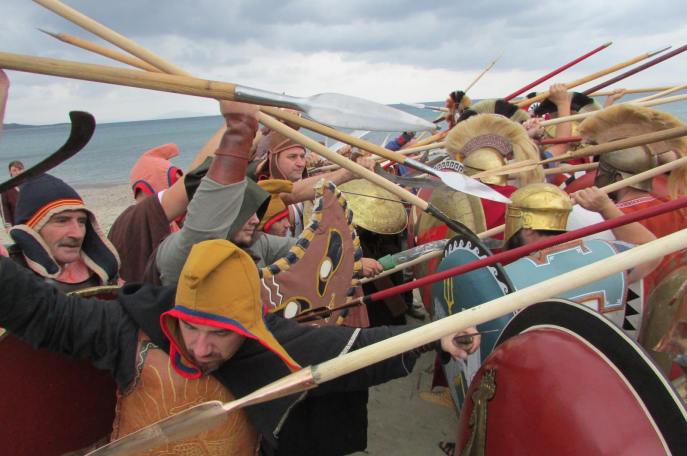
So, over the next two years, we will recruit people; we will build kit from the Greek Aspis (the big shield) which is not easy to make, to the clothes, cook pots, and tents; we will train, both physically, because reenacting is an extreme sport, and as a team, so we can safely execute the maneuvers of the phalanx and the sparpabara; we will plan a fairly complex load-out and air-freight from North America to Greece, while also planning the renting of horses, the movement of groups from across Europe and Asia and Australia; we’ll plan buses from airports and food purchase and delivery and hotels and swimming and showers and restaurants and tours for reenactors who’ve never been to Greece before… Oh, and dozens of meetings; with each other, and with various elements of local and federal Greek governments and archaeologists and journalists and anyone else who wants a piece.
I’ve done this before. Or rather, and this matters, WE have done this before. We’re a team. There are about twenty five of us; we put on Marathon in 2011 and then we did Marathon again in 2015 and now we’re going for the Gold. We have leaders in Australia and the UK and France and Belgium and Germany and Canada and the USA and Spain and Italy; I’m hoping this time we get people from Turkey and even Iran.
You should come. And you can follow our progress here as we march to Plataea. This blog will show the training, the martial arts, the kit-bashing, as well as guest blogs by other reenactors who are attending, from my group and many others, all over the world. The event is two years and two months away…
And if you want to come…
North America?
http://www.boarstooth.net/join
And in the UK Midlands and south) go to http://www.hoplites.org/
Northern UK http://www.comitatus.net/
If you are not in the UK or North America, contact me at christian@boarstooth (dot) net and I’ll find you the group nearest to you.
Writing Fantasy: Baskets and Broadswords
Standard
Lunch on a Medieval trek. Waxed linen bag for food, leather shoulder bag based on a Thames find, Medieval Danish axe, copper canteen based on a 13th c. original.
When people ask me about the impact of reenacting on my books, they almost inevitably follow up with a question about swords and armour. They’re often great questions, and I’m always happy to answer them; I’ve taken a pretty deep dive into a couple of periods and I think I have developed some interesting ‘general usage’ theories of martial arts and warfare. At the end, there’s a nice picture of a fantastic original sword that helped inspire the book Cold Iron.
But the thing is that weapons and armour are actually the least important aspects of reenacting. Even the most keen and hardened warrior (if such people actually ever existed; modern psychology suggests that warriors are either keen or veterans, never both, but that’s another story) only engaged in combat a few days a year, whereas cooking and sleeping and keeping clean happened every day.
The remarkable thing about cooking and cleaning and sleeping and living is not the items you need to do them. You can, with a little online research, reach out and buy a 14th century fry pan and a fourteenth century kettle, and some other very useful kitchen tools. A little more research, and you can come up with recipes and even whole cook books of Medieval food, whether Norse or English, French or Italian.
Even with swords and knives, you can buy an excellent blade; cook’s knives, eating knives, daggers, broadswords.
Ultimately, recreating the past, or understanding a fantasy world, is more about containers than it is about weapons.
Try and find a decent, correct scabbard.
Or a net bag to carry all the vegetables you plan to eat.
Net bags? Did they have those?
What did meat come from, at the butcher’s? What was it wrapped in in 1380? How did split peas come, or dried fish? Flour? How the heck do you keep flour dry when you travel?
Let’s cut to the chase. In the past, most people had to supply their own packaging. Women went to market with baskets and jars and linen bags and probably leaves and scraps of bark too. Men who traveled (often the wealthy) had elaborate sets of equipment not entirely unlike picnic sets to carry food and drink and pots and pans. But even those sets usually came inside a container, and the container was a basket.

These baskets are 20 years old. They have gone wilderness camping, been carried many miles, even gone in airplanes.
Wholesalers provided food already stored in baskets; remember when you bought blueberries and strawberries in baskets? (I do. I’m old.) Most market towns had a ‘women’s’ industry in just making baskets; in early North America, First Nations people made (superb) baskets. They still do. All of the baskets my Medieval group uses are Mohawk baskets made on the Tyendinaga reserve. We use their baskets because they are actual, usable baskets, which look like the ones in Medieval art but will last and last.
We make our own linen bags, and we can never get enough of them. It’s worth knowing that linen was often woven at home, by women, and it cost time and effort, so making little bags was probably not all that common.  To the left is the cover of Ulrich’s brilliant ‘Midwife’s Tale’, perhaps the most important history book I’ve ever read. Lots of it is about women’s economy in the late 18th century. Anyone writing fantasy should read it; anyone with an interest in the lives of women in the past should read it. It includes details of the internal economy of a house; it even includes details on weaving linen. Just remember, when a reenactor, or a fantasy character, makes a bag out of linen… how many hours of someone’s work that little bag may represent.
To the left is the cover of Ulrich’s brilliant ‘Midwife’s Tale’, perhaps the most important history book I’ve ever read. Lots of it is about women’s economy in the late 18th century. Anyone writing fantasy should read it; anyone with an interest in the lives of women in the past should read it. It includes details of the internal economy of a house; it even includes details on weaving linen. Just remember, when a reenactor, or a fantasy character, makes a bag out of linen… how many hours of someone’s work that little bag may represent.
In Northern Europe and North America, people made bark containers; usually birchbark, but sometimes elm. Birch bark was as prevalent in Poland as in Canada; Elm bark was equally popular, and I suspect that in England, the bark of ash and other trees was used instead.
Both of these are bark containers from Poland.
They didn’t wrap things is paper, at least right away. Large scale, commercially successful paper manufacture in a 14th century thing, but that was a fine quality rag paper for printing, and the whole idea of throw-away paper… is not a Medieval idea. Throw-away? Even the baskets can be reused. Linen bags can be washed, better yet, boiled. Netting can be used to hold bulk; woven nets of flax or other fiber (includign bark fiber) were used to hold bulk vegetables and all sorts of other things. When we’re in the woods, we usually use net bags to hold kale and other delectable greenery.
OK, I’m not a big Kale fan. I admit it. In the Middle Ages, they ate it, as long as ‘they’ includes horses.
I’ll finish with leather bags. That’s mine in the top illustration; I’m eating lunch with my Compagnia at the top of Myer’s Hill in the Eastern Adirondacks. That bag is based on a find in the Thames; it has several pockets, and it would have cost real money even in 1380. It allows me to keep all my gear separate; my fire kit (there’s another blog) and my candles and my razor and my little mirror and my eating kit and…
And a fortune in small, carefully wrought items. Why do adventurers not carry these? And why aren’t they the most valuable possession? You can always kill some guy and take his sword, right? But try and find a bag full of useful objects in the outdoors. Try getting a really good dry snug fire kit. I lost mine on Camino in Spain. Still sad.
My point is, though, that your leather shoulder bag is your lifeline; your survival kit. Also your purse. Mine holds some food, always, and a precious wax candle for starting a fire, and other secrets… Remember that in Medieval clothes, no one has pockets. And remember that when you say ‘Oh, in my world they have pockets’ you need to know why people didn’t have pockets in the past…
Alright. that’s enough for today. I’ll stop.
My latest novel is called ‘Cold Iron’ and it is out August 30th in the UK. This is (exactly) what Aranthur’s sword looks like. It is, (in my novel), an artifact of the ancient First Empire; a long sword that has a complex hilt. I take great joy is learning about the complexities of what museum professionals call ‘Material Culture’ because in understanding these things, be they linen bed sheets or swords, I come to understand the nuts and bolts that hold a culture together.
No Writer is an Island
Standard
Cold Iron is the first book in a new series. New series, new world, and one that is, I hope, totally original. I admit that I was itching to write The Red Knight when I started Fantasy in 2011, and I might return to Alba again eventually; I certainly planned a prequel about how Gabriel becomes the Captain, and I also have in mind a series of short novellas about life after the Gates are open… actually, I’ve already written two of them… and the paperback/mass market of the last book, Fall of Dragons is out this week, which is amazing, because I’ll have two Fantasy novels out in the same month…
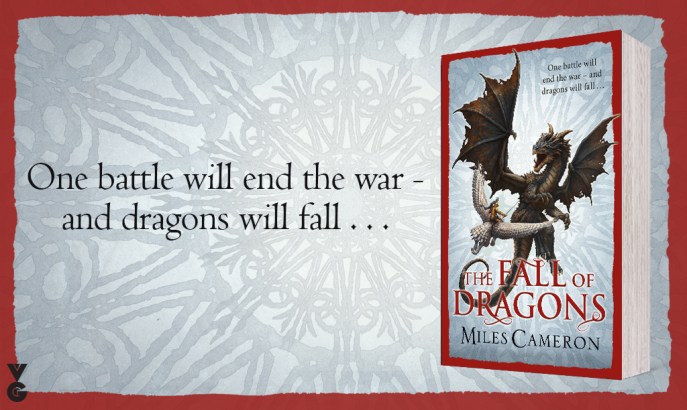
Never mind. While Alba is/was the demi-Arthurian fantasy of my youth, I have long wanted to write a very different, and in some ways more ‘fantastical’ series. Cold Iron is the first in a three-book series, but I hope that there will be other adventures and other protagonists when Aranthur Timos is gone, at least in part because this is a world into which I’ve sunk a great deal of design time. I run an active RPG set there; it isn’t going away soon (See below!).
And I had some goals. Recently a reader pointed out to me that my books tend to have themes. I always knew this in my head, but it was fascinating to have a reader point out that the themes are so strong… William Gold (the Chivalry series, after all) is obviously about the ethics of violence, while the original ‘Tyrant’ series was about leadership and responsibility. And the Red Knight series was also about leadership, or rather, about how a great leader might come to be, in response to a crisis; how there are no great individuals, in my mind, only great teams. I hope that came through; that arrogant and self-centered as Gabriel Muriens is, he is the captain of a brilliant team, and it is the team, not the individual, that triumphs. And Ash’s failure is as much about Ash’s selfishness and inability to delegate as it is about any brilliance of his adversaries.
But I digress, as usual.
Cold Iron also has a theme, and the theme is complex. I have come to believe that fantasy, or at least ‘good versus evil’ fantasy may actually have some role in the creation of the world in which we live; the world of apparent contrasts, of terrorism and refugee crises, of renewed racism and re-born right-wing ideologies. I worry, (despite how much I adore Tolkien and E.R. Eddison, who was himself pretty close to a fascist) that our books, which often portray lone-wolf sword-wielding heroes with piercing blue eyes, relentlessly Northern European cultural signifiers, and various forms of violent masculinity, monarchy and aristocracy and ideas of purity of race (even if the race involved is Elvish), that these books can be read to have a very different message than the one that we intend, or even that most of us receive.
And I’ll add to that, as I put in my blurb in SFX, that I worry that violence and the portrayal and fetishising of violence has become the new pornography. Don’t imagine I think I’m above all this! I love writing fight scenes; especially really large battles; I love martial arts, I enjoy fencing, I shoot guns, etc, etc. I also love writing commanders with piercing blue eyes. I just don’t know it that’s a good idea right now…
So the theme of Cold Iron is, ‘The World is complicated, and the bad guys are not easy to spot, and maybe violence isn’t the way to fix them.’ (It’s funny to say this, as Cold Iron has more sword fights per page then Red Knight. However, it’s there, in the end…) Sometimes it reads more like a spy novel then a fantasy; sometimes, at least in book 2 (Forge of Darkness,already finished and handed in) it may read a little more like horror. Anyway, I confess that if I’m trying to turn the ship of epic fantasy, it’s a slow turn; I still have lots of daring do, and Book Two (Forge of Darkness, but, friends, I recently discovered that Steven Erikson, whose work I very much admire, already has a novel of that title, so I’m going to try for ‘Anvil of Darkness‘ instead) book 2, whatever its title, opens with a major battle scene… it’s not action, it’s the effects of action, and I’m trying, thematically, to use the action to tell a different story about violence, right, and wrong.
All that said, what I really wanted to blog about is the team that makes a book. It’s true that I write them… but I have enormous help. So let’s look at all the people who are involved. Because whatever my message, nothing would get across to you, the reader, unless I had all this support.
First, I have an editor. Her name is Gillian Redfern, and she’s amazing. She’s a great editor, and she’s a thoughtful critic, but the thing about her that’s delightful is that when she’s at a con with her ‘staff’ she’s ‘The Captain.’ She’s fun to watch, as she does all the leadership things so well. Before I knew Gillian, I never thought of editors as captains, but I suppose that’s foolish of me. of course they are, especially in high-pressure social battlefields like SpecFic cons… Anyway, Gillian is a fantastic editor and she makes every book better… and she leads the team that does all the rest.
I also have an American editor at Orbit, named Brit Hvide, and she’s also brilliant. I’ve never met her, but I like her patience and her contributions and, to be honest, I love her twitter feed. And she and Gillian both help me stay current on what’s ‘going on’ in Fantasy, because Fantasy is a very lively genre.
And besides editors, there’s a very different person called the copy editor. Mine is Steve O’Gorman, and he’s the best copy-editor I’ve ever had. He’s ridiculously thorough, but he’s also interested and keen. Cold Iron is much better edited than any of my prior fantasies, and even more fun, Steve made me rationalize my languages to the extent that I got to be a little Tolkienesque and work out how each culture’s language works, what some of their verb forms were, and how we’d form the various modiers. Safian? Safirian? See, when I write, I just write… and I make up words, and as a fan (anti-fan?) on one of the boards recently put it ‘Cameron forgets a lot.’ Unkind readers might add that I can’t spell either. I like to think that a lifetime of reading historic manuscripts has convinced me that spelling, like race and culture, is merely a construct and I should rise above it. Ahem. Regardless, Steve makes it all so much better. Steve is an independent copy-editor; a free lance.

Brittany Sankey at Gollancz is new (to me) but she works in marketing, and she’s provided, for example, the lovely advert blurb that graces the top of the blog. I look forward to getting to know her better. No, I could not graphic design my way out of a sandbox. I need someone to do that for me.
Stevie Finegan is my publicist at Gollancz. She’s also the person at cons who leads me around and tells me where to eat and where to get a pen to sign books. I adore her patience, as I can be a bumbling old fool; and her boundless energy, which may simply be a job requirement, but I like it. Stevie coordinates interviews and magazine articles and all that; because of Stevie, people in the UK have some vague idea who I am. (I have little active publicity in Canada and thus, no one here knows who I am, which is probably the best thing for all of us).

Steve James (almost everyone on my team is named Steve, if you hadn’t spotted that yet, unless they are called Brit…) is one of my oldest friends, and he has drawn the maps for every book I’ve ever written (36 to date).
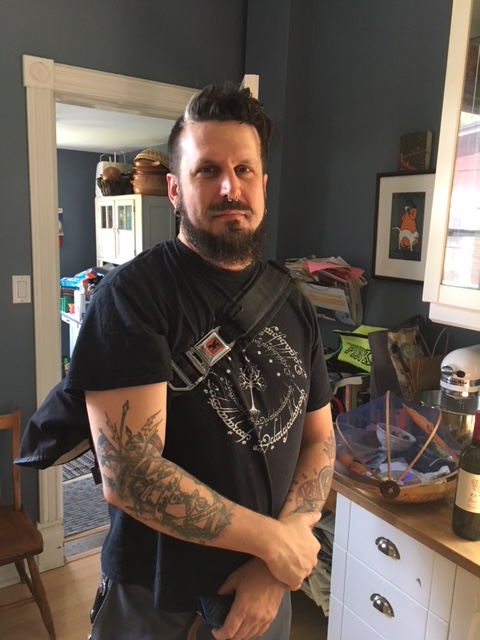
For Cold Iron, he had to draw a world map and then re-draw it about six times as the role playing game and the novel resolved conflicts. I could write a whole blog on how different an RPG is from a novel. In an RPG, everything has to actually work… players routinely ask about distances, days of sailing, supplies, where to buy a donkey…
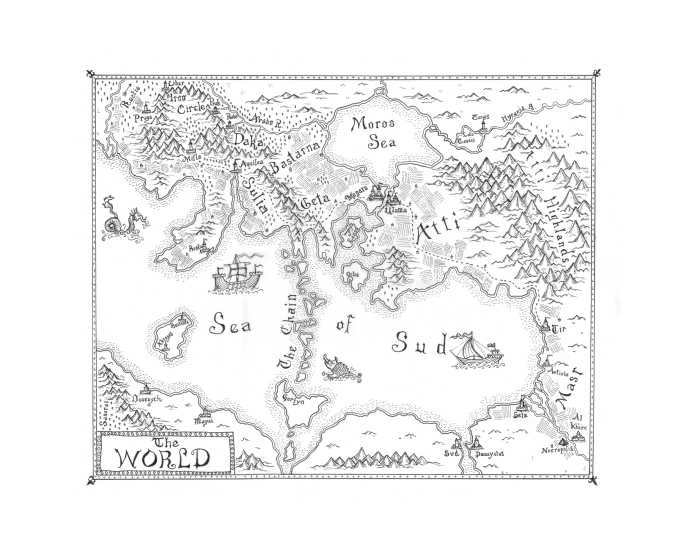
And map-making is a two-way street. Steve’s maps sometimes alter my writing. I look at the map and realize things… sometimes too late to alter the text, but not this time… thanks to Steve, and Steve O’Gorman, the map actually matches the novel. Well, except for one error, all mine. ‘Mitla’ the Imperial city way up in the left top corner, is actually ‘Volta.’ Blame the author. Oh, by the way, there’s the map to the Cold Iron world… or about 1/2 of the known world. Safi, the steppes, and Zhou are off to the east… maybe book two or three… right now (literally now) Steve is making a colour map of the city of Megara… my fantasy city that has some Lankhmar and some Sanctuary and some Merovingen as well as a healthy dose of Venice on top of an solid strata of Istanbul and Athens. Swamps and canals, bridges, a waterfall, an gothic palace, a magnificent university…
Yeah. Steve has to get all that down on paper. Go Steve!
And the newest member of my team is Keight MacLean. Keight is an award-winning Toronto artist; she paints and has a successful career. Luckily for me, she also plays role playing games and reenacts the Middle Ages (so does Steve) and was willing to do some illustrations, so she’s doing the cover for the ‘Reader’s and Players Guide to Cold Iron’ which will be out as freeware next week (a downloadable PDF on my author site … the thing is, we all have to finish working on it first…

That’s Keight at a gallery of her work in Toronto. It’s really good, I own two of her paintings. Also pictured are two photos by Moira Ness, who doesn’t work on my books but whose art I really like…
And here’s an early draft of the painting she’s doing for next week… just to give you some Cold Iron flavour… You can see the painting next week AND DOWNLOAD THE COLD IRON PLAYERS HANDBOOK AND READER’S GUIDE FOR FREE ON MY AUTHOR WEBSITE.
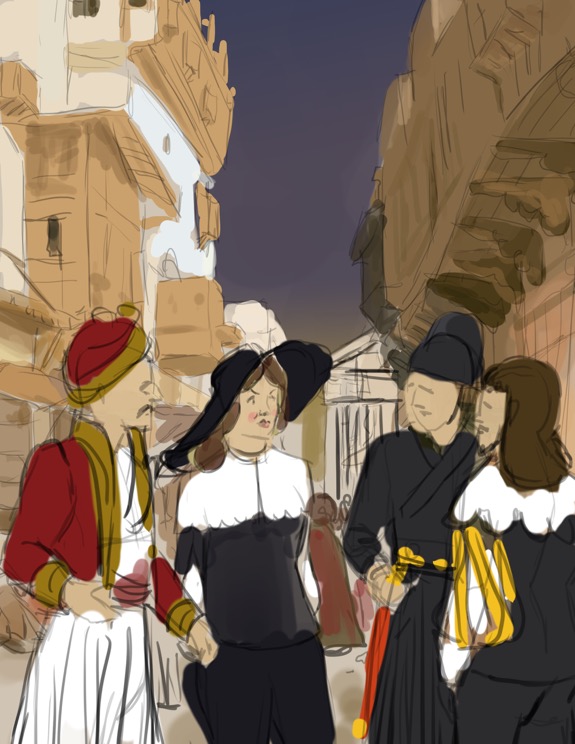
And so far I haven’t even mentioned the cover design team… I don’t actually know their names; and Kerem Beyit, my brilliant cover artist. Even then, I haven’t acknowledged my RPG group who have contributed ideas, character suggestions, and various sharp objects, or my beta readers, several of whom have asked to remain anonymous, so I’ll just say… I wrote a good deal of historical fiction without Beta Readers…how did I ever do that? They’re incredible, they catch name errors, they care about magic systems, and sometimes they just say gushy nice things that make me feel better…
Did I mention the RPG? I have eight permanent players and a half dozen who have made guest appearances, and every one of them… every one… has made a contribution to the eventual novels. BTW, the Cold Iron group still meets and will continue to meet… after all, in writing the novels, I’ve generated a lot of good content, right? 🙂 They’re on a parallel track and never really intersect with the novel’s plot, a trick I learned from Celia Friedman (American SpecFic writer C.S. Friedman, who remains one of the best GMs I’ve ever played with!)
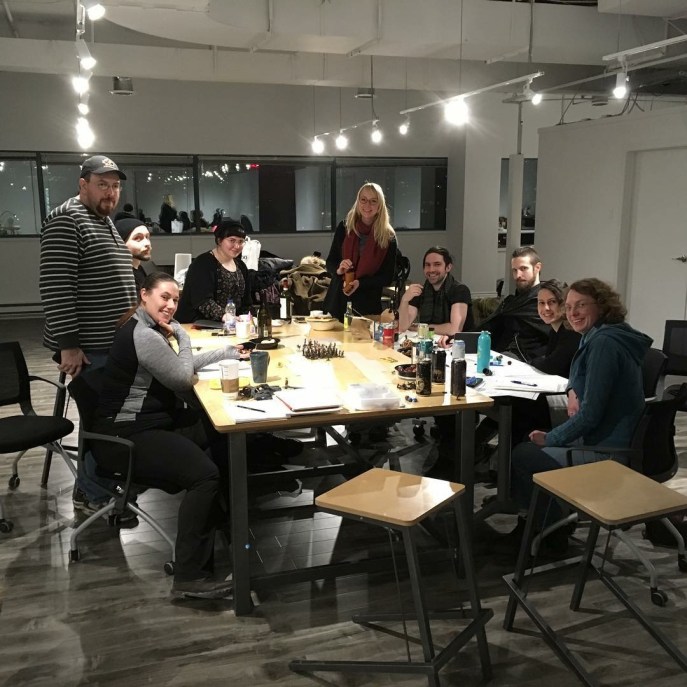
All together, there are about twenty-five people who have contributed to this series. All three of these books will come out over the next 14 months. I hope you like them. If you do, thank all the people who made these books happen. And if you don’t, that’s probably my fault.

On Camino
Standard
Life is really not all about swords, despite what you may think from my other blogs. This spring, with the support and companionship of friends and family, I walked the Camino Primitivo in Spain. In medieval clothes and shoes. You know. As one does.
Now first, I feel the need to tell you that yes, I am religious. I understand when people say ‘I’m spiritual but not religious’ but that’s not enough for me, and I’ve always enjoyed the human pastimes of philosophy and theology almost as much as swordsmanship and role playing games, so walking across the mountains of northern Spain while discussing transubstantiation and immanence and the impact of Duns Scotus and Descartes on modern notions of God (when we had the breath to discourse at all, of course) was marvelous.
And so was prayer. (I have this picture of 200 people closing the browser window at this point). Hey, listen, in normal life, I pray… infrequently. In Spain, my friend Elisabeth and I did compline most nights, and the rhythm of prayer was…remarkable. And very Medieval. I managed Morning Prayer (I’m an Anglican of sorts) a few times, off my cell phone… not nearly as spiritual as reading the BCP. At least, for me.
In addition, I prayed at a dozen or so wilderness chapels, every one of which resembled, to me, the various Arthurian ruined chapels where wandering knights find wise old hermits. Some people in my group suggested that I was old enough to take on the job, which I guess would be flattering, except that I don’t feel particularly wise and I still like to fight in armour, but there’s another story.
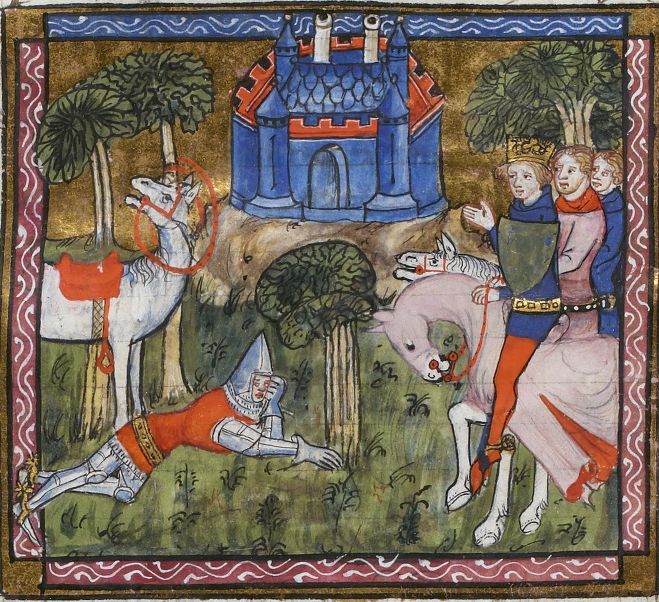
So, there was prayer. But there was also fatigue. The Camino Primitivo has daily elevation changes of almost 1000 meters, all told; the ups and downs are wearing, and the linear distances of 20-30 kilometers are wearing, too, especially in medieval shoes. Hmm. I’m not sure I mean that; my shoes were fine, and years of hiking in and out of the military have convinced me that ankle support is a myth, if your ankles are strong.
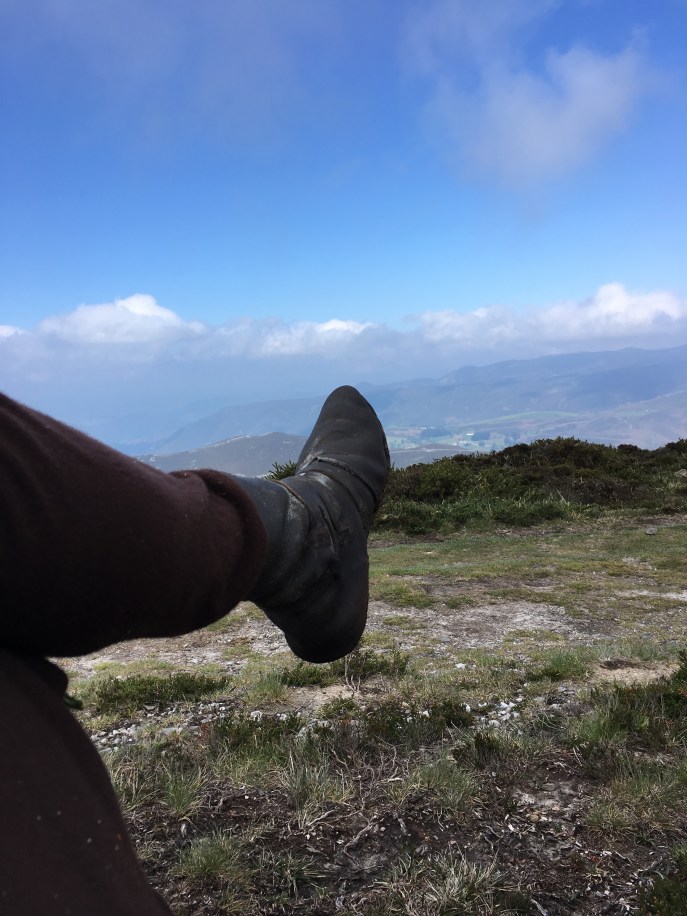
And Medieval clothes are marvelous. People kept asking us, as if we were very brave and super tough, if our clothes were hard to wear, and I’d always say ‘people actually lived in these clothes.’ One very nice couple actually became frosty when I suggested that my clothes were better adapted to the environment than theirs. But in fact… the hood is an incredibly useful garment; separate hose that can be rolled down are the most flexible legwear I’ve ever owned; it takes seconds to change the arrangement, unlike zip on trousers and other ‘outdoor’ wear offered by various outfitters. Wool remains, to me, better than any modern ‘miracle’ fabric. Ditto linen. In my ‘Greenland’ wool cote, I was impervious to 100 KPH winds while I watched various hikers and pilgrims suffering in very expensive ‘outdoor’ wear.
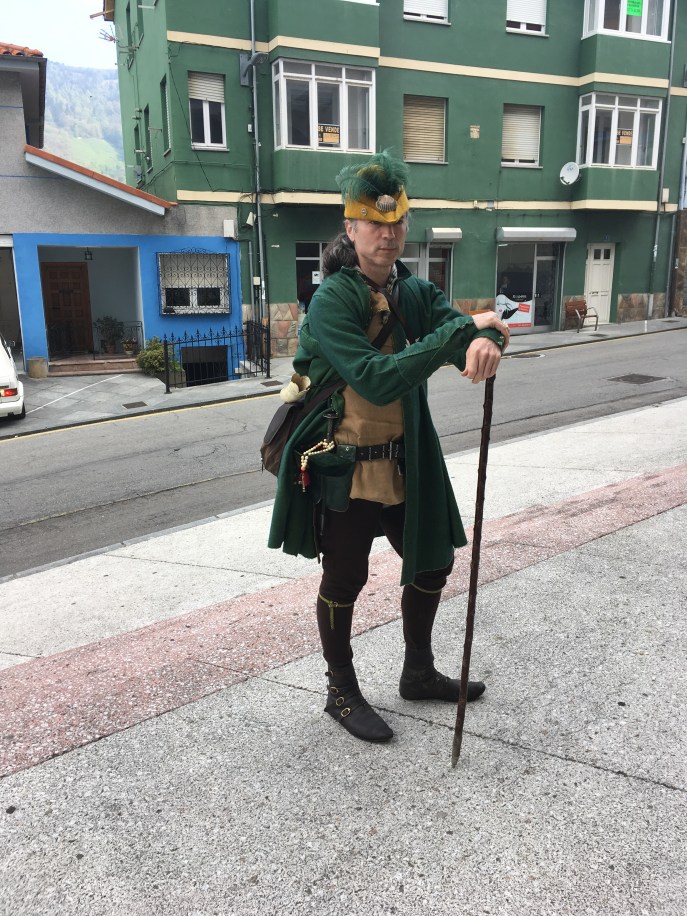
As to weight, I climbed over the Hospitales Route carrying my bedroll and all. It was not easy, but on the other hand, I used everything I brought, so I feel fairly justified. I admit that the rondel dagger was probably the most useless thing… but wait. I didn’t get attacked by bandits, but the triangular blade was awesome at breaking up heavy Spanish chocolate bars…

Here we are, about a kilometer from the top.
None of this really matters. The prayer, the load out, the kit, the views. What matters is walking. Many people told me about the walking, and I didn’t listen, because 1) I can be an idiot and 2) I’ve spent so much time walking, from Africa to the Adirondacks, that I knew all about walking.
Well, Humility will no doubt come with time. The thing about the Camino is that it is there every day. I was constantly reminded of Nathan Greene‘s comment on the American Revolution; ‘We fight, get beat, rise and fight again.’ Every day, no matter how hard the day was, ANOTHER day was waiting. Every morning, no matter how swollen our feet, we had to get up and walk. Eventually, all there is is walking. Everything else falls away; life, family, work, writing, swords, competition, masculinity, poisonous or otherwise; contracts, social media, all slowly stripped away until it’s just walking. Camino means ‘I walk.’
Yep.
Companions help, and mine were the best. My companions never lost it on the trail; we had no spats (until the day was done) and no one walked off. I had fabulous conversations. I heard wisdom, learned secrets, told a few.
And we walked.
After the Hospitales route, and Salas, we were joined by the original inspiration of our Camino, Greg Mele, and his wife, and my friend Steve. And then we were eight (including my daughter Bea) plus my wife Sarah, who became our emergency driver.
These people are hot and tired. But we ‘only’ have 3 kilometers to go in a very, very long day, and we started too late.
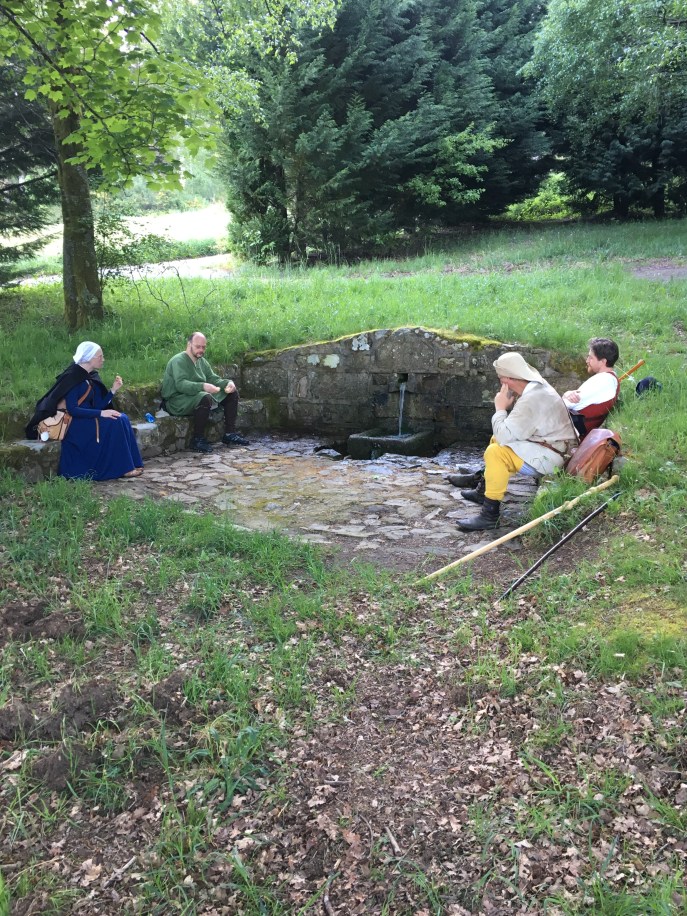
This is one of the most magical places on the whole route, an original pilgrim spring on the Medieval road, complete with benches. And no stinging nettle. Some of us were particularly good at attracting stinging nettle. Ahem.
I’m glad I have these photos, because this is the day I had a fever and I really don’t remember much of the day. In a way, it was the ultimate ‘I walk’ because from time to time, I just had to lower my head and walk on. I wasn’t even in a spiritual space. It was as if I didn’t really exist.
And that loss of self, of worry, of pressure, of stress… I think that’s what everyone was trying to tell me. It’s not about pain, swollen feet, difficulty. I walk a lot; I’m 55, I’m used to being tired. Parts of me hurt every morning, regardless of my fitness level. But there is something MARVELOUS about having nothing ahead but the road. No reward but completion, and maybe a glass of wine. Or compari*. No penalty at all. Stop and rest; stop a day. Stop and work at an albergue for two weeks. Get on a bus and go to Santiago. Whatever.
A little story not my own. Greg Mele swore a vow to do this walk many years ago, when he was recovering from a very serious martial arts injury. He walked it in ten times the pain I was in. I watched him do it. But… I think he also found that feeling that there is nothing but the walk.
It’s quite a feeling.
I haven’t really discussed this with my compadres yet. But when we made it to Santiago; when we’d hugged some friends we made on the road, and some total strangers, in the plaza in front of the cathedral, when we’d hugged each other, when we’d gone to mass, when, finally, we all sat down to eat a huge and well-deserved feast…
I can’t describe it. It was beyond accomplishment. I’d go again tomorrow. Let me revisit this thought… I’ve had a pretty good life, with plenty of adventure, in and out of the military. This adventure was ‘doable’ by a 55 year old man, a 53 year old man, a badly injured man, a couple of middle-aged women… This isn’t a desperate mission behind enemy lines.
Its ‘just’ walking.
It will remain one of the greatest adventures of my life.
My thanks to Greg (Greg Mele, master of Armizare, my own teacher for many years, and also head of Forteza Fitness), for vowing to go, and to Sarah and Bea, for driving the support vehicle, and to my companions, Matt, Elisabeth, Marc, Steve, Tasha (That’s Cotte Simple Tasha!), and Greg, and for a little while, my daughter Bea (who, with a 14 year-old fit body, cruised a 28K day and clearly thought we were all out of shape. Of course, she didn’t do it again 🙂 ) Great companions make great adventures.

And a few more photos…
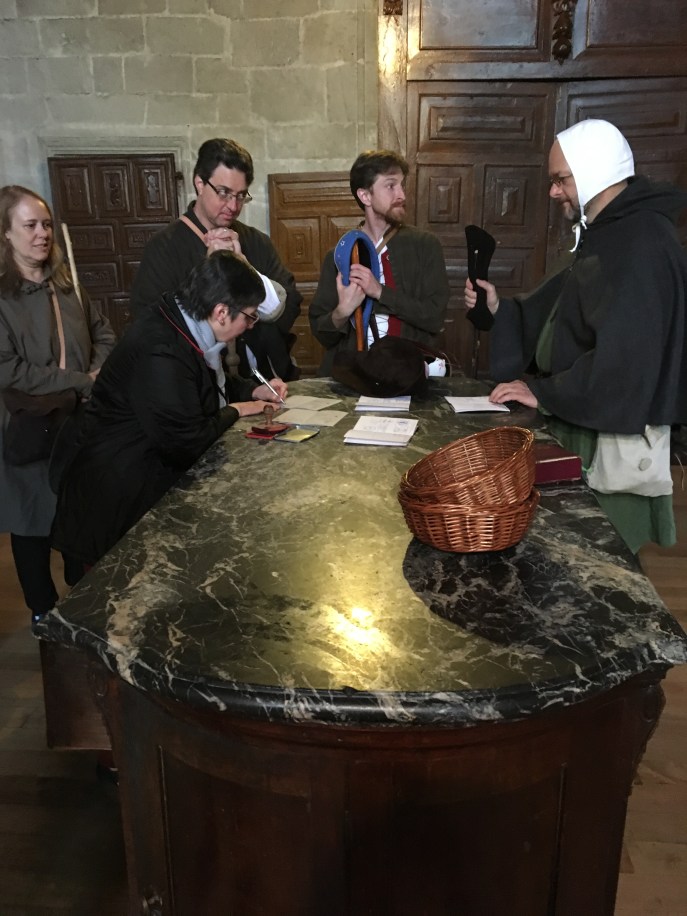
Inside the Cathedral at Lugo, where apparently they thought we were priests and nuns of some very odd American order. BTW this is the Cathedral Vestry, which was larger than my whole church at home.
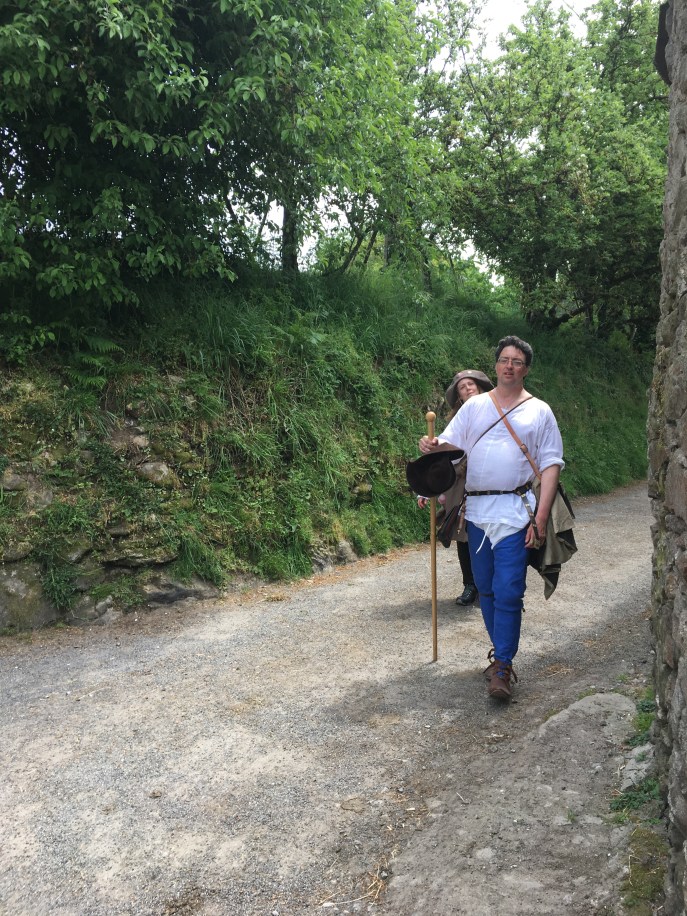
Greg walks. (Tasha, too).

I think Greg and Tasha are in the stream. Seriously, this is from my fever day and I have no idea what’s going on. Good pic, though.

Steve, ready to walk on day 11.
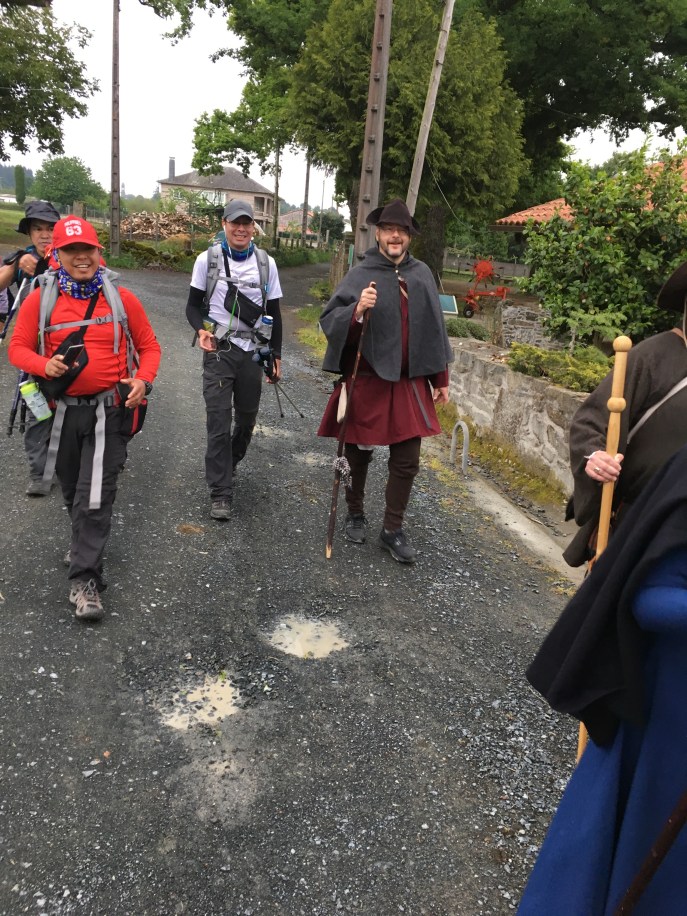
Once we linked up to the main Camino, it was like this all the time. Pilgrims everywhere. Jolly, happy people with only a couple days to go.
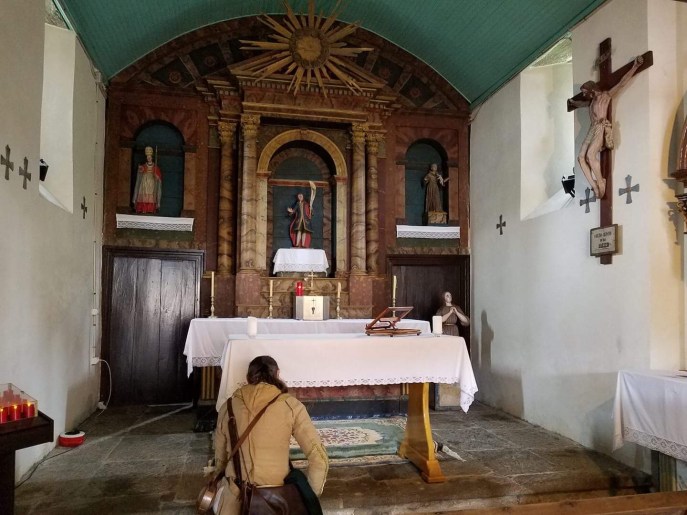
Almost there, in so many ways.
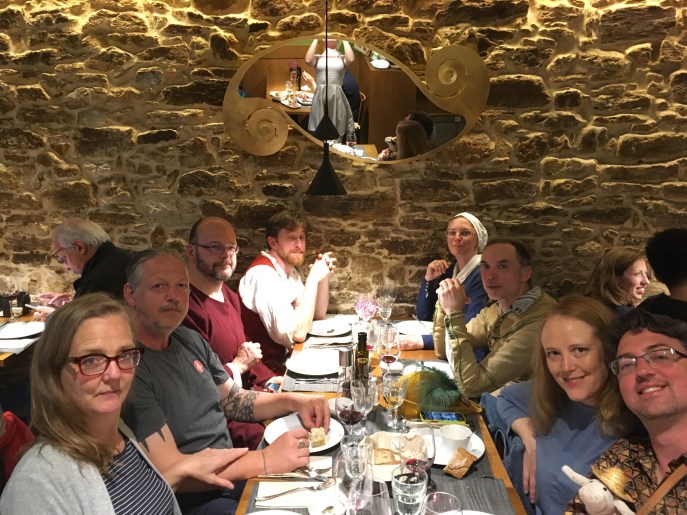
The feast!

Pilgrims going to mass on Trinity Sunday. One days pilgrims FILLED the cathedral.
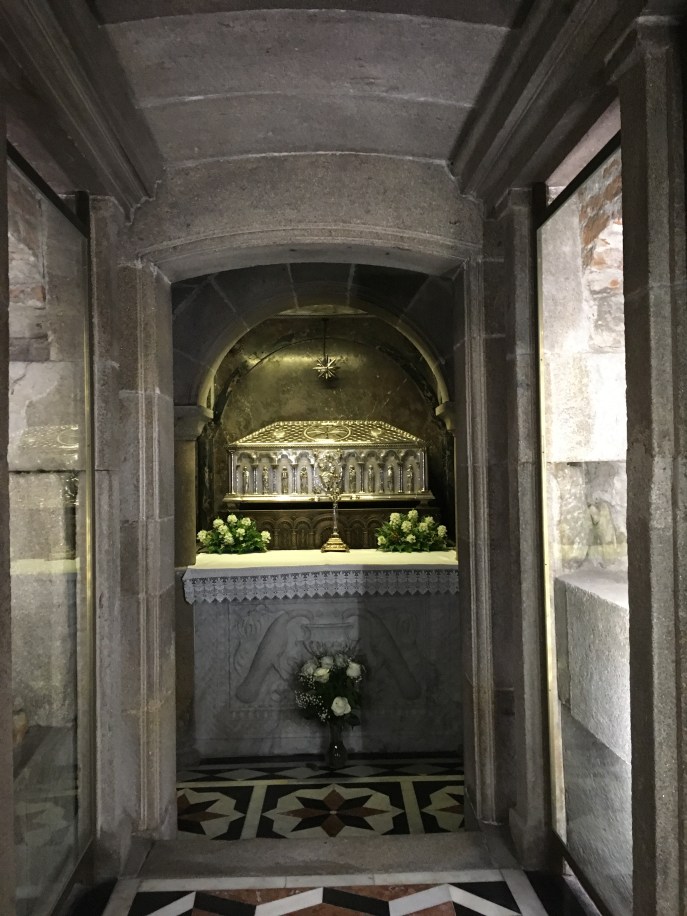
I had Saint James, if it is indeed Saint James, all to myself for a while. Seems like a good place to end. I’ll probably write more on this later, with less rant and more contemplation. And talk about how all of it was practice for a tournament.
Sure it was.
Try it!
*Oh yeah, Compari. So we all started drinking Compari after the Tournament of the White Swan in Verona back in 2014. As one does. And an important part of life on the Camino Primitivo is that if you walk into a town at 3PM, NO ONE will feed you until 7PM at the earliest. But they will give you stale chips, and booze. One particular evening, after the Hospitales route, when we were all exhausted, an inexperienced Albergue keeper poured us highball glasses FULL TO THE BRIM of Compari. And gave us very small bottles of soda water to add. Buon Camino, indeed. I could barely do laundry; walking to dinner was challenging.
Yum. Compari.
Rhodes: Writing about Sieges (Pen and Sword tour Part 1)
Standard Today I was in the mines beneath the walls of Rhodes; I walked along the ditch where you can see where cannon and other artillery have knocked holes in the masonry, and I looked out over the glacis to where the Turkish trenches were; to where Demetrios the Besieger sat in the fourth century BCE. Rhodes has endured quite a few sieges, and the evidence is all around; from catapult rounds pre-weighed and marked in Mina and Talents, to the pock marks of harquebus fire where someone tried, and apparently failed, to storm a gate.
Today I was in the mines beneath the walls of Rhodes; I walked along the ditch where you can see where cannon and other artillery have knocked holes in the masonry, and I looked out over the glacis to where the Turkish trenches were; to where Demetrios the Besieger sat in the fourth century BCE. Rhodes has endured quite a few sieges, and the evidence is all around; from catapult rounds pre-weighed and marked in Mina and Talents, to the pock marks of harquebus fire where someone tried, and apparently failed, to storm a gate.

Sieges may seem dull. In the imagination, a siege represents days or weeks of boredom, slaves and lowly soldiers digging in the burning sun, or waiting to starve out a powerful enemy, or perhaps waiting for disease to do its work. But the walls and tunnels of Rhodes show a different story, of determined, daily resistance and equally determined attackers; daily raids and counter-raids much like WWI trench raids; a handful of knights and their men-at-arms emerging, perhaps, from tunnels to try and hit a Turkish battery, an elite assault group of Janissaries or Spahis creeping along the ditch to attempt to surprise an outpost. A deadly, endless form of warfare, with no quarter asked or given; probably mostly fought at night.

And let us not forget fighting in mines… the purpose of mining was to undermine (it’s all in the word) a weak section of wall, a good way to cause a breech, even in modern times. Once gunpowder was invented, a mine could be filled with powder.

The defenders could always counter-mine, using primitive sounding tools to locate the wound of the enemy sap and attack it underground by tunneling. And that’s what we see under the walls of Rhodes, I think, the old tunnels wandering off in odd directions were once Turkish and Hospitaller saps, later redug and transformed into underground sally ports. If this theory is correct, these tunnels can tell us a great deal about what mine warfare was like in the Middle Ages. If you are reading this and you know something about the tunnels under the walls of Rhodes, feel free to email me; I know they were there in the 1850’s and they look original to me, but I’d be happy to hear more.
Assuming they are what they appear to be, complete with shafts to the surface and oil-lamp sconces built into the walls, they are perhaps unique in the world. I could write a book….
